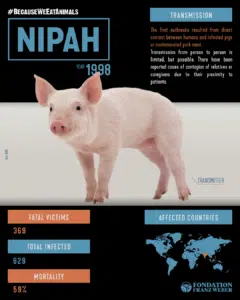#BecauseWeEatAnimals: NIPAH virus (NiV)
What is Nipah? The virus, which is little known in Europe, can cause encephalitis and has spread several times throughout Asia since 1998. In particular, the intensive farming of pigs has proved to be a critical factor in human infection. In Malaysia, as a precautionary measure and in order to stem the further spread of the virus, half a million pigs have subsequently been killed.

Origin: Nipah is a zoonotic disease, meaning that it is transmitted from animals to humans. We know that the virus’ natural host is the fruit bat, of the Pteropus genus. Three transmission pathways have been identified:
- Via raw date palm sap contaminated with secretions from infected bats (Luby, Gurley y Hossain, 2012).
- Humans coming into direct contact with secretions from infected bats (Montgomery et al., 2008)
- Via domestic animals. A study on the Nipah outbreak in Malaysia indicated that 92 % of those infected had been in contact with pigs (Parashar et al., 2000) whose food could have been contaminated with excrement from infected bats (Looi and Chua, 2007). In the case of the outbreak in Bangladesh, there is evidence that transmission was via cows (Hsu et al., 2004), pigs and goats (Luby, Gurley and Hossain, 2012).
Country: Malaysia, Bangladesh and India (WHO).
Year / First cases: The first known outbreak occurred in Malaysia between 1998 and 1999 (no new outbreaks have been reported there since then). In 2001, a new outbreak was identified in Bangladesh, and outbreaks have been recorded in this country almost every year since. The disease has also been periodically detected in eastern India (WHO).
Fatality: Malaysian outbreak 1998/1999: 105 fatalities (Looi and Chua, 2007). Outbreaks Bangladesh 2001/2018: 198 fatalities (WHO). Outbreaks in India 2001/2018: 62 fatalities (WHO).
Symptoms: Infected sufferers initially develop symptoms including fever, headache, myalgia, vomiting and sore throat. This may be followed by dizziness, drowsiness, altered consciousness and neurological symptoms indicating acute encephalitis. Some people may also experience atypical pneumonia and severe respiratory problems, including acute respiratory difficulty. Encephalitis and seizures occur in severe cases, progressing to coma in 24 to 48 hours. Source: WHO
Social and economic implications:
According to Singh et al., (2019), the practice of rearing animals as a source of additional income in many Asian countries is a predisposing factor in the emergence of novel zoonoses such as the Nipah virus (Bhatia and Narain, 2010). Furthermore, some studies have shown that Nipah emerged as a result of interaction between wild animals (bats) and domesticated animals reared in intensive conditions (Daszak et al., 2013).
The outbreak spread to Singapore, but was swiftly contained by putting a complete ban on imported pork meat from Malaysia. In Malaysia, then, the virus triggered the culling of over one million pigs and the destruction of at least half of the farms in insular Malaysia (Steele, P, G. et al., 2006). Given the socioeconomic and geographic nature of the virus’ fatality rates, efforts to develop a vaccine were not the same as on other occasions. The infection hit only a certain number of poor communities, confined to rural areas, thus complicating trials of a potential vaccine and reducing economic incentives for research (Román, 2018).
The pig-farming industry, predominantly in Bikut Pelanduk, did not require workers with a high level of education. Once the farms closed, therefore, these workers and families ‒ who had earned a living from pig-rearing for several generations ‒ were confronted with their lack of education and job prospects, and soon experienced worsening financial situations (Chi Wan, NG. et al., 2009).
The wider economic impact of the 1998 Nipah outbreak in Malaysia was estimated at US$ 582 million. Losses affected sectors indirectly related to the pork industry (for example, the feed industry) and an estimated 36,000 people lost their jobs from a wide range of business activities (De Smith et al., 2019).
More information:
- Read more on our project page «Corona and other pandemics»


